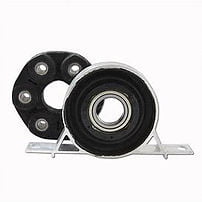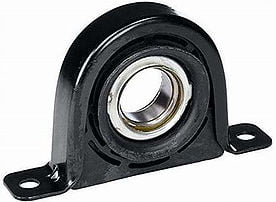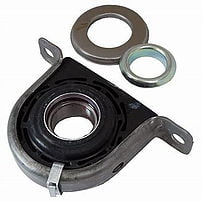No products in the cart.


As more cars on Australian roads pass the ten-year mark, workshops across Melbourne are seeing a rise in driveline issues. Among them, centre bearing wear is becoming increasingly common. It is a small component, but when it fails, the consequences can be significant.
The centre bearing sits midway along a two-piece tailshaft. Its job is to support the shaft as it rotates, keeping it aligned between the gearbox and the differential. This alignment is critical in rear-wheel and all-wheel drive vehicles, where torque is delivered to the rear axle. The bearing absorbs movement and vibration and helps ensure a smooth transfer of power from the engine to the wheels.
But while the tailshaft is built from steel or alloy, the centre bearing is surrounded by rubber. Over time, that rubber breaks down. Heat, road debris, and constant flexing take their toll. Eventually, the bearing starts to sag or split. That allows the shaft to move excessively under load, throwing off balance and increasing stress on other driveline components.
In practical terms, the warning signs are subtle but familiar. A vibration under acceleration. A low-frequency rumble at highway speeds. A slight clunk when shifting into drive. Drivers may not recognise these symptoms as mechanical faults. In many cases, they are misattributed to tyres, wheel alignment, or general wear and tear.
“If the bearing is failing, the tailshaft doesn’t stay in line,” says a Matt Sadler, owner GJ Drivelines, a Melbourne workshop that specialises in driveline and tailshaft repairs. “That extra movement wears out the universal joints more quickly. It can even cause the shaft to rub or strike the underbody.”


However, if left too long, the repair becomes more complex. Damaged shafts may need to be re-tubed or replaced. Worn joints can affect alignment and increase transmission wear. In extreme cases, driveline failure can result in loss of power delivery or safety risks on the road.
At GJ Drivelines, technicians carry out centre bearing replacements, tailshaft balancing, and driveline repairs for passenger cars, light trucks and commercial fleets. The workshop also provides custom shaft builds for vehicles with modified suspension or drivetrain layouts.
Drivers who notice a vibration or knocking noise under acceleration are encouraged to have the vehicle inspected. Mechanics recommend that cars approaching 10 years of age — especially those with rear-wheel or all-wheel drive — should have the centre bearing checked as part of scheduled servicing.
With driveline faults often mistaken for more superficial issues, awareness is key. Mechanics say preventative maintenance is the best way to avoid the compounding costs of delayed repairs.
For Melbourne drivers with ageing vehicles, especially those used for work or travel, a centre bearing inspection may be a small step that prevents a much larger problem.
Chrysler – Dodge
727 – 30 Spline 1 11/16″ Seal Diameter
904 – 26 Spline 1 9/16″ Seal Diameter
Ford
C6-T56 – 31 Spline 1 11/16″ Seal Diameter
AOD & C4 & T5 – 28 Spline 1 1/2″ Seal Diameter
4 R 7OW – 28 Spline 1.598″ Seal Diameter
General Motors
T-350 700R4-4LLOE – 27 Spline 1 1/2″ Seal Diameter
T-400-4L80E – 32 Spline 1 7/8″ Seal Diameter
Note: Transmission slip yokes are manufactured with various U-Joint Series. It is important to match Horsepower and Torque requirements to U-Joint Series. For aftermarket transmission applications usually a spline count and seal diameter will identify slip yoke required.

If Pinion Yoke has Placement tabs that retain the U-Joint, measure inside tabs. See Diagram D.

If Pinion Yoke does not have Placement Tabs that retain U-Joint, measure from flat of yoke inside to inside. See Diagram E.

If 4 bolt Flange is used on pinion, measure Pilot Diameter and center to center diagonally bolt hole to bolt hole. See Diagram L.

Universal Joint Size. There are hundreds of U-Joint sizes or “Series” to accomodate many different applications of power and desired longevity for your automotive, 4×4 truck or auto racing requirements, these 4 series of joints cover most needs.
1310 Spicer Series: 1 1/16″ Cup Diameter (Dim C – Diagram A) 3 7/32″ length (Dim B – Diagram A) Certain Ford applications have 2 cups 1 1/8 Diameter. Appropriate horse power range is up to 500 in circle track or road racing, small tire drag racing and 4×4. Also available: Performance Dynamic Cryo Joint.
1330 Spicer Series: 1 1/16″ Cup Diameter (Dim C – Diagram A) 3 5/8″ length (Dim B – Diagram A) Certain Ford applications have 2 cups 1 1/8 Diameter. Slightly stronger than 1310, Used in 5.0 Mustangs. Also available: Performance Dynamic Cryo Joint.
3R Saginaw Series: 1 1/8″ Cup Diameter (Dim C – Diagram A) Retained with internal clip 2 5/8″ (Dim B – Diagram A). Most common GM joint. Horse power range up to 700 in road racing and circle track. Solid drag racing U-Joint can accomodate most sportsman classes. Also available: Performance Dynamic Cryo Joint.
1350 Spicer Series: Manufactured with OEM tolerances and treated with our Cryogenic Process to yeild the strongest U-Joint available. For drag racing applications a solid non-lube design U-Joint is recommended because of the tremendous initial shock load, or short duration of high torque the joint must be able to withstand.

If PST is supplying you with transmission slip yoke, Pinion yoke and driveshaft yoke measure Dim W. See Diagram N.
If PST is supplying you with transmission slip yoke and driveshaft measure Dim X. See Diagram N.
2 Piece driveshafts use Dim Y + Z. See Diagram N.